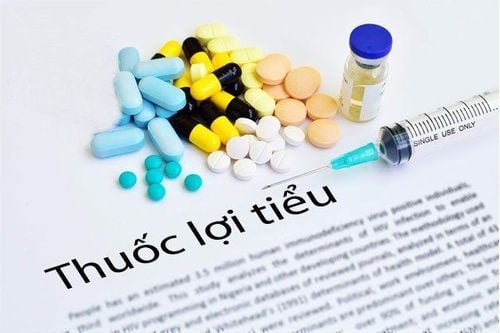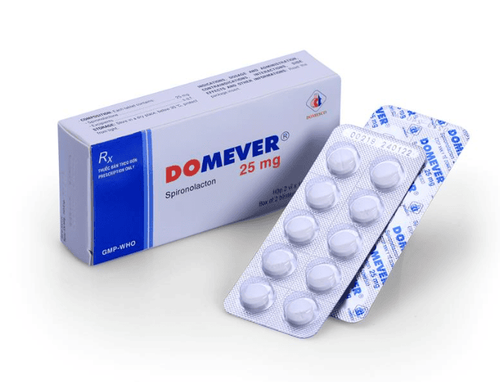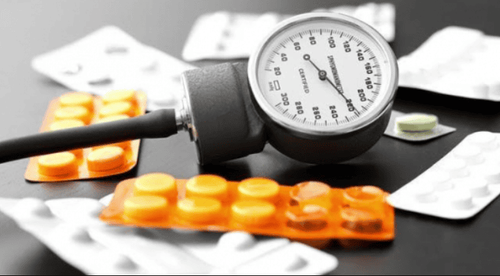This is an automatically translated article.
Furosemide is a sulfonamide-derivative diuretic, this active ingredient belongs to a group of powerful, fast-acting and dose-dependent drugs that act on the ascending arm of the loop of Henle, so Furosemide is also known as a loop diuretic. Furosemide is the main active ingredient present in Furosan.
1. What is Furosan?
What is Furosan? Furosan is a brand name drug of Hasan - Dermapharm Joint Venture Company. The drug has the main ingredient is Furosemide, the content of 40mg is made in the form of tablets.
Furosemide inhibits the Na+/K+/2Cl- co-transport system in the ascending loop of Henle, increasing the elimination of these electrolytes with increased water excretion. Furosemide also reduces the reabsorption of Na+, Cl-, and increases the elimination of K+ in the distal tubule. Loss of potassium, hydrogen and chlorine can cause metabolic alkalosis, besides the drug reduces plasma volume, so Furosemide can cause hypotension but usually only a slight decrease. Furosemide also has the effect of vasodilating the renal vessels, reducing the resistance in the renal vessels and increasing the blood flow through the kidneys. In patients with congestive heart failure associated with acute myocardial infarction, after administration of furosemide, glomerular filtration rate was transiently but significantly increased, peripheral vascular resistance decreased, and peripheral venous blood volume increased.
When high doses of Furosemide are used in patients with chronic renal failure, glomerular filtration rate may increase temporarily; however, if diuresis is excessive because Furosemide reduces plasma volume, decreased blood flow may occur. kidneys and decrease the glomerular filtration rate.
2. Uses of Furosan
Furosan drug with active ingredient is Furosemide, this is a diuretic recommended for use in all cases requiring fast and highly effective diuretic:
Treatment of edema in congestive heart failure, kidney disease, cirrhosis of the liver, nephrotic syndrome, pulmonary edema; Treatment of peripheral edema due to mechanical obstruction, venous insufficiency or treatment of mild to moderate hypertension; Hypercalcemia disease.
3. Dosage of Furosan
Furosan is taken orally. The dose of Furosan should be adjusted in patients with low blood protein levels such as patients with congestive heart failure or liver failure. When using furosemide concurrently with Colestipol, cholestyramine, these drugs should be taken 2-3 hours apart.
Dosage of Furosan for adults and children > 12 years old: The starting dose of Furosan is 40 mg/day in the morning, then it can be maintained or reduced, the number of times Furosan is used depends on the patient's condition. ; The maintenance dose of Furosan is 20 mg/day or 40 mg, given every other day. For persistent edema, the dose of Furosan can be increased up to 80 mg/day. Furosan medicine to treat high blood pressure: Furosan dose is 20-40mg/time, 2 times/day. If a dose of Furosan 40mg twice a day does not achieve a therapeutic effect, the doctor should consider combining it with another antihypertensive drug rather than continuing to increase the dose of Furosan. Treatment of hypercalcaemia in adults with mild increase in blood calcium concentration: Take Furosan at a dose of 120mg/day. Dosage of Furosan for children under 12 years old: It is recommended to use another dosage form that is more suitable for children in this population. For the elderly: Furosemide is eliminated more slowly than in the elderly, so it is necessary to adjust the dose of Furosan to meet the treatment requirements. Note: The above dosage of Furosan is for reference only, the specific dose of Furosan depends on the condition and progression of the disease, in order to have an appropriate dose, patients need to consult their doctor or pharmacist. medical specialist.
4. What to do in case of accidental overdose of Furosan?
Manifestations of Furosan drug overdose: Water and electrolyte imbalance with symptoms of headache, muscle weakness, cramps, thirst, drop in blood pressure, loss of appetite, rapid pulse... For patients with cirrhosis, too much Furosan doses can lead to hepatic coma.
Treatment: give the patient to replace the lost water and electrolytes.
5. Furosan drug side effects
When using Furosan, patients may experience undesirable effects:
Side effects of Furosan are very common: Dehydration, hyponatremia, metabolic alkalosis, hypochloremia, hypocalcemia, decreased blood magnesium, lower blood pressure, calcium kidney stones in children. Common side effects of Furosan on metabolism and nutrition: Volume depletion. Uncommon side effects of Furosan: Non-regenerative anemia, impaired glucose tolerance, hyperuricemia, gout, decreased HDL levels, increased levels of LDL and triglycerides, increased blood sugar, visual disturbances, visual disturbances blurred vision, yellowing sensation, deafness (sometimes irreversible), cardiac arrhythmias, increased risk of patent ductus arteriosus in premature infants, dry mouth, thirst, nausea, intestinal motility disturbances, diarrhea diarrhea, constipation, cramps, muscle weakness, decreased urination, urinary incontinence, urinary obstruction, fatigue, increased blood transaminases. Rare Furosan side effects: bone marrow depression (need to stop using Furosan), eosinophilia, leukopenia, psychosis, paresthesia, confusion, headache, tinnitus and hearing loss Reversible sensation, vasculitis, thrombosis, shock, acute pancreatitis, liver dysfunction, asthenia, fever, anaphylaxis, skin rash, pruritus, photosensitivity, infectious epidermal necrolysis poison. Furosan side effects of unknown frequency: metabolic alkalosis (in patients with decompensated cirrhosis), fluid and electrolyte disturbances, increased potassium excretion, dizziness, syncope, loss of consciousness, pruritus, erythema multiforme, purpura, exfoliative dermatitis, pruritus, allergic reactions, dermatitis (urticaria, blistering skin lesions, acute generalized exanthematous pustulosis). Instructions on how to handle side effects of Furosan: Check electrolytes regularly, supplement with potassium or use potassium-sparing diuretics if hypokalemia. Reduce dose or stop treatment with Furosan if side effects are moderate or severe.
6. Contraindications of Furosan
Furosan is contraindicated for use in the following cases:
Patients with hypersensitivity to furosemide and sulfonamide derivatives; Patients with anuria, renal failure (creatinine clearance < 30ml/min/1.73 m2) or renal failure due to nephrotoxic or hepatotoxic drugs; Electrolyte disturbances, fluid loss, hypotension; Concomitant use with potassium supplements or potassium-sparing diuretics; Hepatic coma, hepatic coma; Addison's disease ; Digitalis poisoning; Women who are breastfeeding.
7. Be careful when using Furosan
Use caution when using Furosan in the following cases:
Should treat hypotension, hypovolaemia and any acid-base disorders before using Furosan. Hypotension may lead to dizziness, syncope or loss of consciousness in patients treated with Furosan, especially in the elderly; Adjust the dose of Furosan carefully (to reduce the risk of ototoxicity) in patients with hypoproteinemia (nephrotic syndrome...) and moderate hepatic congestion; Furosan should be used with caution in cases of liver failure, renal failure and hepatorenal syndrome, diabetes mellitus, the elderly, patients with difficulty urinating or at risk of urinary obstruction such as benign prostatic hypertrophy. , gout, the patient is at risk of falling due to hypotension; It is necessary to regularly monitor patients for hematopoietic disorders (discontinue Furosan immediately if occurring), liver damage, increased risk of calcium stone formation, renal lithium stones in premature infants; During treatment, it is necessary to monitor the BUN index regularly; There may be an increase in serum creatinine and urea levels, and serum cholesterol and triglyceride levels may increase but will return to normal within 6 months of using furosemide; Furosan medicine can cause headache, dizziness, fainting, hypotension, decreased mental..., should warn patients to drive, operate machinery, work at height or people performing other jobs. Other dangers require alertness and concentration; Pregnancy: teratogenicity on embryonic development has not been well established in humans. However, Furosan should not be used in pregnant women, unless the benefits outweigh the risks; Lactation: Use of Furosan during lactation has the risk of inhibiting lactation, breast-feeding should be discontinued if Furosan is necessary. Furosemide in Furosan may be distributed into milk or inhibit lactation, so caution should be exercised in nursing women.
8. Drug interactions of Furosan
Drug interactions of Furosan drugs can occur during the following process:
Concurrent use of Furosan with antihypertensive drugs will increase the antihypertensive effect. Furosan should be discontinued or the dose reduced before starting an ACE inhibitor because furosemide can interact with kidney damage. Hypokalemia due to furosemide increases the risk of cardiotoxicity, avoid concomitant use of Furosan with pimozide. Increased risk of ventricular arrhythmias when Furosan is used with Amisulpride or Sertindole; Increased antihypertensive effect when taking Furosan with phenothiazines; Taking Furosan with antiarrhythmic drugs (amiodarone, disopyramide, sotalol...) increases the risk of cardiotoxicity (due to hypokalemia); The effects of lidocaine, tocainide, mexiletine may be antagonized by furosemide; Taking Furosan with Cardiac Glycosides can cause hypokalemia and electrolyte disturbances, increasing the risk of cardiotoxicity; Increased antihypertensive effect when taking Furosan with Thymoxamine or Hydralazine; Taking Furosan with renin inhibitors: Aliskiren reduces the plasma concentration of furosemide; Taking Furosan with nitrates increases the antihypertensive effect; Furosemide reduces the excretion of lithium, thereby increasing the plasma concentration of lithium, increasing the risk of toxicity. Therefore, the concomitant use of lithium with Furosan should be avoided unless the plasma concentration of lithium is controlled; Sucralfate may reduce the gastrointestinal absorption of furosemide, should be administered 2 hours apart; Taking Furosan with lipid-modifying drugs - reducing bile acids will reduce the absorption of Furosemide, so these drugs should be used 2-3 hours apart; Taking Furosan with non-steroidal anti-inflammatory drugs (NSAIDs) increases the risk of nephrotoxicity, and Indomethacin and Ketorolac may antagonize the effects of furosemide. Taking Furosan may increase the risk of ototoxicity induced by Aminoglycosides, Polymyxins or Vancomycin. In addition, Furosemide can also reduce vancomycin plasma concentrations after cardiac surgery; The hypoglycaemic effect of antidiabetic agents is antagonized by the active substance furosemide, so an increase in insulin dose may be required; Antiepileptic drugs: Furosan increases the risk of hyponatremia (carbamazepine), reduces the diuretic effect (phenytoin); Taking Furosan with CNS depressants (clopromazine, diazepam, clonazepam, halothan, ketamine) increases the antihypertensive effect. Furosan drug with active ingredient is Furosemide, this is a diuretic that is recommended for use in all cases where rapid diuresis is required. To ensure effective use, patients need to carefully read the instructions and consult with the doctor, pharmacist for advice, to limit the risk of unwanted side effects.
Follow Vinmec International General Hospital website to get more health, nutrition and beauty information to protect the health of yourself and your loved ones in your family.













